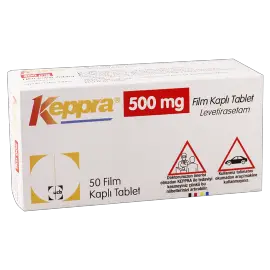
Key points
- Keppra is a medication that contains levetiracetam as the active ingredient. It is a commonly used anticonvulsant for dogs suffering from seizures and epilepsy. It can be used alone or combined with other drugs such as phenobarbital and potassium bromide.
- Keppra can be given to dogs in the form of regular or extended-release tablets, liquid oral solution, or injections.
- Keppra has minor to no side effects. When present, typical side effects include drowsiness, appetite loss, behavioral changes, diarrhea, and vomiting.
- You should never stop giving your dog Keppra without a veterinarian’s approval since it can cause your dog to have more frequent and severe seizures. Never give your dog double or extra doses of Keppra as well.

Keppra is one of the many brand names for levetiracetam, an anticonvulsant commonly prescribed for conditions such as seizures and epilepsy. Statistics show that about 5% of all dogs suffer from seizures at some point in their lives. Dogs experience attacks when there is increased electrical activity in their brains, resulting in temporal behavioral abnormalities. Generally, seizure episodes are not life-threatening to your dog, and with an appropriate medication regimen, you can ensure your pet’s long-term health and well-being.
In most cases, veterinarians will prescribe phenobarbital and potassium bromide to dogs as a seizure treatment. But sometimes, these remedies are ineffective, and some dogs don’t tolerate them well or experience unpleasant side effects. In those cases, Keppra is used as an alternative anticonvulsant treatment.
Table of Contents
How To Administer Keppra?
Keppra can be used alone or combined with phenobarbital or potassium bromide to increase its efficacy. When used in combination with other drugs, the dosage of Keppra should be reduced. Keppra can also alleviate the side effects of phenobarbital or potassium bromide, which often include sedation, loss of coordination (ataxia), and behavioral changes.
Keppra can be administered as 500 mg or 750 mg regular or extended-release tablets. It can also be given in the form of a liquid oral solution or as injections in clinics and veterinary hospitals. You can administer Keppra with food or on an empty stomach, but if you see any symptoms of stomach upset in your pet, give the drug with food.
Keppra takes about 1-2 hours to act, but you can’t always see the drug’s effect in action, so sometimes lab tests are needed to assess whether the medication is working for your dog. The effect usually lasts for 8 hours if your dog takes regular tablets and around 12 hours if it receives extended-release tablets.
Keppra Dosage For Dogs
Usually, levetiracetam is given three times a day, which is more frequent than other anticonvulsants, but if extended-release tablets are prescribed, then you should give your dog Keppra two times a day. This will prevent the pet from having an overdose.
Keep in mind that you shouldn’t crush or split extended-release tablets and if there’s a risk that your dog may chew them instead of swallowing, try sticking to regular formulation tablets. You don’t have to monitor your pet’s blood parameters when it receives Kepptra treatment.
Keppra is one of the many medications that are prescribed off-label for dogs, which is why it’s essential to strictly follow your veterinarian’s recommendations instead of sticking to what is stated on the label. If you accidentally skip a dose, give it as soon as you remember, unless it’s time for the next one. If it is, skip the missed dose and return to the regular schedule, but never give your dog a double dose of levetiracetam. Try to give each dose at the appropriate time because it’ll help to control your dog’s seizures properly.
Keppra Side Effects For Dogs
Levetiracetam is generally safe for dogs, but scientists are still conducting more studies to assess possible side effects. However, it has been proven that this drug doesn’t affect the liver or liver enzymes in the same way as phenobarbital and potassium bromide. Keppra is not broken down by the liver, and it is secreted into the urine. This makes Keppra a safer option for dogs with certain liver diseases or impaired liver function.
Generally, dogs taking Keppra will experience minor, if any, side effects. Keppra can potentially cause the following side effects:
- Drowsiness
- Appetite loss
- Behavioral changes
- Gastrointestinal symptoms such as diarrhea or vomiting
Keppra’s effect on your pet should cease within 24 hours, but dogs with liver and kidney conditions may experience the effects of the drug for a longer time. If you see your dog experiencing an adverse or allergic reaction after taking Keppra, seek veterinary help immediately.
You should be extra careful when giving the medication to dogs with kidney or liver disease, pregnant or nursing dogs. Also, don’t give Keppra to dogs that have had allergic reactions to the drug in the past.
Don’t stop administering levetiracetam to your dog unless a veterinarian advises you to do so. A sudden interruption in treatment can result in stronger withdrawal seizures which can even be life-threatening to your dog.
Keppra’s Interactions With Other Drugs
Levetiracetam should be used with caution if your dog takes any of the following medications:
- carbamazepine
- methotrexate
- central nervous system depressants
- nonsteroidal anti-inflammatory drugs (NSAIDs)
- phenobarbital
Make sure to let the veterinarian know about all the medication your dog is taking, including vitamins, dietary supplements, and herbal therapies.
Natural Alternatives to Levetiracetam
Even though levetiracetam has significantly fewer side effects than traditional seizure medications like phenobarbital and potassium bromide, some pets will still experience undesired reactions. That’s why many pet owners look for natural alternatives to conventional medicines.
VitaminA is a natural remedy for dog seizures with no side effects, and it’s commonly used as an active ingredient in many human anti-seizure medications. In the past few years, it has become widely used in veterinary medicine for many purposes, including treating epilepsy in dogs. However, as with any off-label remedies, you should consult a veterinarian before administering any new treatment to your pet.
FAQ
Is Keppra a good seizure medication for dogs?
Yes, Keppra is a good alternative for dogs that don’t respond or respond poorly to conventional seizure medications such as phenobarbital or potassium bromide.
What is the best seizure medication for dogs?
The best medications to treat dog seizures include potassium bromide, phenobarbital, levetiracetam, zonisamide, and primidone.
Should I give my dog Keppra?
Keppra is generally safe for dogs, and many veterinarians prescribe it as a seizure treatment. Unlike other anti-seizure drugs like phenobarbital and potassium bromide, it does not affect the liver or liver enzymes.
How much Keppra should my dog take?
The general rule is to give your dog 20 mg of Keppra per 1 kg of body weight, but the precise dosage should be determined by a veterinarian.
Should Keppra be taken every 12 hours?
Keppra can be taken twice a day every 12 hours, or three times a day if your dog takes extended-release tablets.








